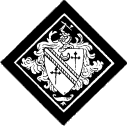
1. Delf. 4. Point dexter. 7. Gore sinister. 2. Inescutcheonreversed. 5. Point pointed. 8. Gusset dexter. 3. Plain Point. 6. Point champaine. 9. Gusset sinister.
"And Edward the Third of England ordained two of six stars which a gentleman had in his arms to be effaced, because he had sold a seaport of which he was made governor." [According to Sir George Mackenzie, in allusion to AYMERY OF PAVIA, a Lombard, governor of Calais in 1349, who bore azure, four mullets or.]There is another mark of disgrace which is due only to the traitor: is consists in debasing or reversing the entire coat.
Azure, a chevron between six rams accosted, counter trippant, 2, 2, and 2 argent, attired or--HARMAN, Suffolk.Accroupi, (fr.): said of a lion or wild beast in a resting posture.
The arms of the bishops of Winchester and Oxford(the one, prelate, and the other, chancellor of the order of the garter) should be encircled by the garter, and have their badges pendent. The archbishops of Armagh and Dublin bear the badge of the order of S.Patrick in the same manner. Prelates having temporal jurisdiction, (as the bishops of Durham had,) may bear a crosier and sword saltirewise behind their arms; the hilt of the sword should be uppermost.5, 6. The dean of a cathedral or collegiate church, or the head of a college, whether married or not.--The insignia of the deanery or college impaled with the paternal coat must be placed upon a ground parted per pale white and black, as in No. 4. A dean or other clerk should by no means bear a helmet, mantle, or crest.
The deans of Windsor, Westminster, and S.Patrick's, Dublin, should bear the badges of their respective orders.7. Kings of Arms.--The achievement of a king of arms should contain the insignia of his office and his paternal coat impaled together, and surmounted by his helmet, crest, mantling, and crown. Some kings of arms have encircled their shields with the collar of SS belonging to their office. The ground of this achievement must be, like the above, per pale white and black.
 |
| Achievement in case of a Bachelor. |
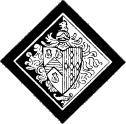 |
| Achievement in case of a Husband. |
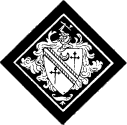 |
| Achievement in case of a Knight. |
According to some modern heralds it is not proper for a knight to include the arms of his wife within the collar, ribbon, or other insignia of his order. In compliance with this opinion it is customary for the achievement of a knight(whether a peer or not) to be arranged thus:--Two shields are placed side by side, the first, which is encircled by the garter or other distinction of the order, contains the husband's arms alone, and the second those of the husband and wife. Both these shields are included within the external ornaments pertaining to the husband's rank. The ground is perpendicularly divided at the middle of the second shield, the dexter side black, the sinister white.2. A husband of any rank, whose lady is a peeress in her own right.--Two escutcheons; the dexter containing the arms of the husband with the lady's upon an escutcheon of pretence ensigned with her coronet: the sinister lozenge-shaped, with the lady's alone. Each must be accompanied by all its proper external ornaments. The ground should be perpendicularly divided at the middle of the dexter escutcheon, and painted black and white.
Marriages previous to the last one should not be noticed upon achievements.
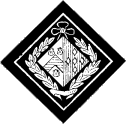 |
| Achievement in case of a Widow. |
Sire Rauf de Cheyndut, de azure, a un cheyne de or, e un label de goules--Roll of Arms, temp. EDW. II.Acorned, (of an oak)=fructed with acorns(fr. englanté).
Argent, three martlets azure, on a chief gules an acorn between two mullets or--CAIRNS.
An acorn slipped and leaved--Seal of town of WOKINGHAM.
Argent, three acorns slipped vert--AIKENHEAD and TATTON.
Vert, three acorns or--HARDING and SMITH, Middlesex.
Quarterly, per fess indented first and fourth gules in chief a maunch argent, in base an acorn sprig--AKERMAN, Surrey.
Argent, three cups of acorns, azure--ATHUL.
Acorns are also borne by the families of ASHTON, Marketfield; ATASTER(or AKASTER); BRETTELL, Worcester; BOYS; CROMIE, Kildare; CUDDERLEY, Derby; DALLING; DUNCAN, Essex; FYFIELD; IFIELD; JOHNSON, Warrington; PALMER, Middlesex; SEVENOKE, and others.
Gules, an adder nowed or--NATHERLY.Addorsed, or endorsed(fr. adossé): said of two animals turned back to back. These terms(generally the latter) are also used with reference to axes(bills), to keys, when the keybits or wards are turned outwards, and to other similar objects, and more especially to wings and heads of birds, &c.
Sable, three chevrons ermine between as many adders argent--WISE, Warwick. The same between three adders erect or--WISE, Brompton. Also embowed vert--WISE.
Vert, three adders erect argent--HASSELL, Wraysbury.
Azure, on a bend argent, three adders embowed of the first--CASTLETON, Surrey.
Argent, three viper's heads erased proper--HATSELL, 1708.
Vert, three asps in pale or--ASPENDALL.
Argent, two lions rampant addorsed, the 1st azure, 2nd gules--LUCAS.Adextre par, (fr.): having a charge on the right or dexter side.
Sable, two greyhounds endorsed argent--BARNARD, Hants.
Sable, two bills addorsed in saltire argent--BILLINGFORD, Norfolk.
Azure, an eagle's wings endorsed or--EDMUNDS, Lyndhurst.
Gules, two keys addorsed in bend or, interlaced with a sword in bend sinister argent, hilt and pomel of the second--PLIMPTON Monastery.
Sable, on a mount vert, two stags salient affrontant argent, attired or--JOHN FISHER, Bp. of Exeter, 1803; Bp. of Salisbury, 1807-25.Affronty, (fr. de front): facing the spectator(as the lion in the crest of Scotland), or in full aspect, which is the more correct term when applied to a bird. It is applied to a helmet, savage's head, &c. [See a remarkable example given under Monastery.]
Gules, two greyhounds salient affrontant or--DOGGETS, Norfolk.
Per saltire, or and argent ... in the chief centre section an open helmet affronty unbarred proper ... --POWER.African. See Man.
Gules, three savage's heads affronty erased argent--VIGNE.
Azure, a bull's head affronty couped at the neck argent, between two wings or .... HOSTE.
Argent, three bunches of alderberries proper--ALDERBERRY.Alembick. See Limbeck.
Gules, three allerions displayed or--LIMESEY.
Or, on a bend gules, three allerions argent--Duchy of LORRAINE.
[These arms are supposed to have originated from the circumstance of Godfrey of Boulogne, duke of Lorraine, shooting three allerions with an arrow from a tower of Jerusalem "upon the direction of a prophetick person." A far more probable supposition is, that the arms were intended as a play upon the name of the duchy.]Alesé, or Alaisé(fr.), when an ordinary does not extend to the edge of the shield: but the English term couped is more usual, and of a cross humetty, §7.
Gules, a chevron argent between three alligators .... --HITCHCOCK.
Per chief gules and or, in base an olive-tree eradicated and fructed proper, in chief the head and fore-legs of a crocodile issuant proper--DALBIAC, Bedford.
 |
| Allocamelus. |
[The Company was incorporated 1579, and Charter confirmed by Charles II.]Allumé: applied by French heralds to the eye of a beast or bird when touched with red.
Argent, an almond slip fructed proper--ALMOND.
Sable, an eagle displayed between two bendlets argent; on a chief or three almond leaves vert--JORDAN, Surrey.
 |
| Altar. |
Sable, on a fesse dancetty of four, between three lions rampant gardant argent, each supporting an altar or, flaming proper, nine billets of the field.--SMIJTH, of Hill Hall, Essex.Altar tomb. See Church.
 |
| SKIPTON. |
Argent, an anchor sable--SKIPTON.Anchored(fr. ancré), or ancred. See under Cross moline, §24.
Gules, an anchor argent, the ring or--ZACHERT.
Gules, an anchor argent, the stock or--GOADEFROY.
Azure, a lion rampant supporting a cabled anchor or; on a chief wavy .... --RICHARDSON.
Argent, an anchor erect(without a stock) proper, environed on the centre with the letter C or--CLEMENTS INN.
An anchor between two smaller ones, within the beam and fluke--Seal of NAVY OFFICE. [See also MARINERS' Company, Newcastle-on-Tyne, under Whistle.]
Argent, on a chevron sable three angels kneeling, habited in long robes close girt, their hands conjoined elevated upon their breasts, wings displayed or--MAELOR CRWM, Caernarvon.Angemnes, (lat. ingemmœ): a series of round ornaments. See Sexfoils.
Azure, a pillar erect between two angel's wings, elevated or--AWBORN.
Gules, an Angel standing erect with hands conjoined and elevated on the breast, habited in a long robe, girt argent, wings displayed or--BRANGOR(or Berenger) of Cervisia, 1413.
 |
| Angles. |
Azure, three pairs of Angles interlaced fesswise; at each end an annulet azure--WASTLEY.Anille. See Fer de Moline.
 |
| ANLETT. |
 |
| conjunct. |
 |
| embraced. |
 |
| interlaced. |
| Annulets. |
Azure, three annulets argent, (of another branch or)--ANLETT.(See also under roundles 'faux rondelets'.)
Sir Nicholas de VEPOUND de or a vj aneus de gules--Roll, temp. ED. II.
Sire Johan de CROMWELLE de goules a vj aneus de or--Ibid.
Monsire de BARTON de Fryton port d'ermin, sur fes gules trois anneletts d'or--Roll, temp. ED. III.
Argent, two annulets linked together gules, between three crosses formy sable--THORNHAGH, Nottingham.
Argent, two annulets conjunct sable, within an orle of trefoils slipped vert--John ETON.
Ermine, three annulets interlaced in triangle gules--MANDERE.
Gules, six annulets embraced or, two, two and two--BRACER.
Gules, six annulets interlaced palewise in pairs, and a chief or--CLENCH.
Argent, nine annulets in saltire interlaced[chain], five gules and four azure--HATCHET.
Ermine, three annulets, one within another, gules--FYTTON.
Vert, an ant argent--KENDIFFE.
Sable, on a chevron between three ant-hills or, each charged with four ants proper, as many holly leaves azure--Benedictine Abbey of PERSHORE.
Argent, a bend azure between three emmets sable--MASSY.
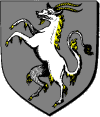 |
| HARRIS. |
Argent, an heraldic antelope gules, tusked, horned, maned and hoofed or--ANTILUPE.With the heraldic Antelope must be grouped the Ibex, which resembles it, although belonging to the goat-tribe.
Sable, an antelope salient argent, attired, unguled, tufted, and maned or--HARRIS, Monm. and Devon.
Argent, on a bend gules, three antelopes passant of the first, attired or--HALLIWELL, Lancaster.
Azure, a fess nebuly ermine between three antelope's heads erased argent--SNOW, London.
Sable, three antelope's heads couped argent armed or--BRUSARD.
Argent, a fess engrailed between three ibexes passant sable--SEDBOROUGH, York.Antique, (fr.): a word not infrequent in the blazoning of coats of arms, signifying that the charge, &c., is to be drawn after the antique or ancient manner; e.g. an antique crown, boot, bow, escutcheon, ship, temple, plough, hulk, &c. The antique crown, for instance, is encircled by a series of plain triangular rays.
Lozengy argent and vert, on a bend azure an annulet in chief of two heraldic ibex's heads or--Sir John YOUNG, Lord Mayor of London, 1466.
Argent, a lion rampant gules, crowned with an antique crown or--ROCHE, Ireland.
Azure, an antique bow in fess, and arrow in pale argent.--MULLER.
Or, on a lion rampant sable, an antique escutcheon or, charged with a cross patty gules--POWNALL.
 |
| Anvil. |
Per chevron argent and sable, three anvils counterchanged--SMITH of Abingdon, Berks.Apaumy, or Appalmed, (fr. appaumé): said of a hand open, shewing the palm. The term is, however, scarcely necessary, as every hand not blazoned as aversant, or dorsed, is supposed to be appalmed.
Azure, an anvil or--ARNULF.
Gules, a smith's anvil argent--ANVAILE or ANVIL.
Vert, an arrow fesswise in chief and a dexter hand apaumy couped in base argent--LOUGHMAN, Ireland.Ape: this is the only representative of the Quadrumana used as a charge; a monkey occurs sometimes as a crest.
Sable, a chevron or between three apes argent, chained of the second--LOBLEY.Apollo: a figure of Apollo, as the inventor of Physic, occurs in the insignia of one Company.
Vert, an ape sejant holding up the paw braced round the middle, and chained to the sinister side of the escutcheon argent--APPLEGH.
Azure, Apollo proper with the head radiant, holding in the left hand a bow, and in the right hand an arrow or, supplanting[or bestriding] a serpent argent--APOTHECARIES' Company[inc. 1617].Apple, (fr. pomme): the apple-tree is rarely borne; the fruit is more frequently so.
Argent, an apple tree vert fructed proper--ESTWIRE.Apple of Granada. See Pomegranate.
Gules, a bird argent standing upon an apple or--CONHAM, Wilts.
Argent, a fesse sable, between three apples gules stalked vert--APPELTON.
Argent, on a bend sable, three apples slipped or--APULBY.
Azure, a bar argent; in base three apples erect proper--HARLETON.
Azure, a bar argent; in base three apples transposed or--HARLEWYN.
 |
| Apre. |
The sinister supporter of the arms of the Company of MUSCOVY Merchants.Aquilon, (fr.): the north wind is represented by an infant's features with the cheeks puffed out(perhaps used only in French coats of arms).
Quarterly azure and argent a cross moline or, in the first quarter the sun in splendour; in the second the ark on the summit of Mount Ararat, and a city at the base, with this inscription in the Armenian language, NAKSIVAN; in the third quarter the angel Raphael and Tobias standing on a mount, thereon a fish proper; in the fourth an anchor with the cable entwined in band or--RAPHAEL, Ditton Lodge, Surrey.Arbalette, (fr.): a steel cross-bow.
 |
| ARCHES. |
Gules, three arches, two single in chief, and one double in base argent, the imposts or--ARCHES.Arched, or Archy: said of an ordinary which is embowed.
Gules, three arches conjoined in fess argent; caps and bases or--ARCHES[Harl. MS. 613].
Gules, three arches azure--ABRENCIS or AVERING, Kent.Ardent, (fr.): inflamed and burning.
 |
| Argent. |
Argent, simple--BOGUET, Normandy.Ark: See Noah's Ark.
Blank ung rey de soleil de goules--RAUF DE LA HAY, Roll, temp. 1240.
 |
| TREMAYNE. |
Gules, three dexter arms conjoined at the shoulders, and fixed in triangle[like the legs in the ensign of the Isle of Man], vested or, with fists clenched, proper--TREMAYNE, Cornwall.An Arm, when used as a Crest, more frequently holds a dagger, arrow, &c.; also two arms sometimes occur.
Sable, three dexter arms conjoined at the shoulder, and fixed in triangle, vested or, cuffed argent, the fists clenched, proper--ARMSTRONG.
Gules, three dexter arms braced[i.e. vambraced] argent, hands proper--ARMSTRONG, Ballycumber.
Gules, a naked arm embowed, issuing from the sinister holding a battle-axe erect proper--HINGENSON, Bucks.
Gules, an arm in armour proper, holding a Danish battle-axe argent--HINGSTON, Holbeton, Devon.
Gules, issuing from the sinister side a cubit dexter arm unvested, fesswise grasping a sword proper--CORNOCK, co. Wexford.
The arm is also borne by the families of ARMORBERY--DE LA FAY--PUREFOY--BORLASE--ARMORER--RENNCEVALE--HANCOCK--CHAMBERLAYNE, and many others.
Argent, three bars azure, over all an eagle with two heads gules, armed or--SPEKE, Cornwall.When the term is applied to arrows it refers to their iron points: and when a Man is said to be armed at all points it signifies that he is entirely covered with armour except his face.
Vert, a horse thereon a man in complete armour, in the dexter hand a sword proper--MAGUIRE.Armoyé, (fr.): charged with a shield of arms.
Sable, a chevalier in full armour with halbert proper--ARGANOR.
Sable, a demi-chevalier in plate armour, couped at the thighs proper, holding in his dexter hand a battle-axe--HALFHEAD.
A man on horseback in full speed, armed cap-a-pie, and bearing on his left arm his shield charged with the arms of France and England quarterly; on his helmet a cap of maintenance; thereon a lion statant guardant ducally crowned; his dexter arm extended and holding a sword erect, the pomel whereof is fastened to a chain which passes from the gorget; the horse fully caparisoned--Seal of the Town of WALLINGFORD.
A man in armour also borne by families of MONCURRE, ANSTROTHER, ARMSDRESSER, O'LOGHLEN, GRIMSDITCH, NEVOY, &c.
 |
| WILLIAM I, &c. |
 |
| STEPHEN. |
Gules, two lions[or leopards] passant gardant in pale or.Some ingenious writer, knowing that the Sagittarius was ascribed as the badge of KING STEPHEN, substituted it for the lions in the Royal arms, but following late examples, placed three instead of two upon the shield.
 |
| HENRY II. |
 |
| RICHARD I.(?) |
Gules, three lions passant gardant in pale[called the lions of England] or.These arms appear very distinctly upon the great seal of his successor, RICHARD I., but there is a second great seal of this king(perhaps even earlier), in which a portion of the shield is shewn, and(possibly by carelessness of the die-cutter) this contains a lion counter-rampant.
Le Roy de ENGLETERRE, porte de goules a iij lupars passauns de or--Roll, temp. ED. II.
 |
| EDWARD III. |
Quarterly 1 and 4; azure semy of fleur-de-lis or[for France] 2 and 3, arms of ENGLAND.On the seal is represented, for the first time, a distinct crest(a lion passant on a chapeau).
Azure, a cross patonce between five martlets or.HENRY IV. bears on his great seal the same arms, and apparently a similar crest. The badges of HENRY V. are sometimes given as the supporters of the arms of HENRY IV., but on no good authority.
 |
| JAMES I. |
Quarterly, I. and IV. counter quartered: 1 and 4 FRANCE; 2 and 3 ENGLAND. II. Or, a lion rampant within a double tressure flory counter flory gules--SCOTLAND. III. Azure, a harp or stringed argent--IRELAND.These arms were continued to be used by CHARLES I., CHARLES II., and JAMES II., and are usually represented in carving, painting, &c., with the same supporters, namely, the lion and the unicorn. It may be noted, however, that CROMWELL, as Protector, bore:--
Quarterly 1 and 4; argent a cross gules[i.e. of St.George, for ENGLAND]. 2, Azure, a saltire argent[i.e. of St.Andrew, for SCOTLAND]. 3, Azure, a harp or, stringed argent[for IRELAND], and on an escutcheon surtout sable a lion rampant gardant argent[for CROMWELL].WILLIAM and MARY bore the same arms, but the former with an escutcheon surtout bearing the arms of NASSAU(Azure, semé of billets and a lion rampant or).
Quarterly 1 and 4, ENGLAND impaled with SCOTLAND; 2 FRANCE; 3 IRELAND;GEORGE I. and GEORGE II. the same, except that in the fourth quartering the arms of HANOVER were substituted for ENGLAND.
Quarterly 1 and 4 ENGLAND; 2 SCOTLAND; 3 IRELAND; an escutcheon with the arms of HANOVER surtout ensigned with the electoral bonnet[afterwards with a crown].GEORGE IV. and WILLIAM IV. the same. VICTORIA as follows:--
Quarterly 1 and 4 ENGLAND; 2 SCOTLAND; 3 IRELAND.From JAMES I. onwards the Lion and Unicorn remained the supporters, generally with the same motto, Dieu et mon droit.
 |
| STANDARD. |
Vert, an arrow in pale, point downwards, or, barbed and feathered argent--STANDARD, Oxfordsh. [A particular arrow was called a standard, and hence this is a canting coat.]When arrows are in bundles such bundles are called sheaves of arrows(the number and position being in some cases mentioned).
Gules, two arrows in saltire argent, over all a fess chequy of the second and first--MACAULAY.
Argent, two arrows in saltire, points upward azure between four 5-foils of the last--JAMESON.
Per pale embattled gules and azure an arrow in bend or, barbed and feathered argent, point upward--CUGLER, Hertfordshire.
Gules, three arrows double pointed or--HALES.
Gules, three bundles of as many arrows argent--BYEST, Salop.A bird-bolt again differs, not being barbed as an ordinary arrow: it may be described as a blunt-headed arrow used to shoot birds, and shot from a cross-bow. An old French word, 'boson,' also occurs, which appears to mean the same.
Gules, three sheaves of arrows points upwards argent--JOSKYN.
Gules, three bundles of as many arrows, two in saltire and one in pale or, feathered headed, and tied in the middle with a string argent--BESTE.
 |
| Bird-bolts. |
 |
| Broad arrow. |
Argent, three cross-bows bent, each loaded with a three-headed bird-bolt sable; a chief vert--SEARCHFIELD, Bp. of Bristol, 1619.A broad arrow differs somewhat, perhaps, from the above in the head, and resembles a pheon(q.v.), except in the omission of the jagged edge on the inside of the barbs. By the term broad arrow, the head alone is meant. The bolt and the quarrel were shorter arrows, used with the cross-bow.
Argent, three bird-bolts gules, headed and feathered or--BUSSHAM, Lincolnshire.
Argent, three bird-bolts in fess gules--BOLTON.
Argent, three bird-bolts in pile gules--BOUZUN.
Argent, three bird-bolts gules, headed or, and feathered of the first--BOWMAN, Norfolk.
Or, three bird-bolts gules, nooked and pointed of the first; a label gules--BEARUM.
Sire Peres BOSOUN de argent a iij bosons de gules--Roll, temp. Hen. III.
Argent, three broad arrows azure--HALES, Stafford.Arrow-head. See also Pheon.
Gules, a broad arrow between two wings argent--ZINGELL.
Argent, three bolts in pale gules--BOLTSHAM, Devon.
Gules, three quarrels argent--BAGGSHAM.
Arrows are also borne by the families of ARCHARD, HYAM, ZINGEL, TINGEWICK, FLOYER, FORSTER, and many others.
Argent, an ash-tree proper issuing from the bung of a tun--ASHTON, Cornwall.
Argent, an ash-tree vert--ESTWREY. [By one branch of the family a chevron vert between three bunches of ashen keys proper.]
Argent, on a chevron gules between three branches of rowan[or rodey] tree proper, as many crescents or. [Also by another blazoning between three trees proper, fructed of the second]--RODEY, Liverpool.
Argent, on a chevron azure, between three branches of mountain-ash vert, as many crescents of the first--ROWNTREE.
 |
| Ashen keys. |
Argent, three ashen keys vert between two couple-closes sable--ASHFORD, Devon.Ash. See Colour.
Argent, a chevron between three branches of ashen keys vert--ASHFORD, Cornwall.
Or, an eagle in full aspect gules, standing on a perch issuing out of the sinister side argent--BODY.Aspectant: used improperly for respectant.
Gules, on a mount vert a stork in train aspect to the sinister argent--ARNALT.
Sable, an ass argent--ASSIL.Assaultant, or Assailant: i.q. Salient.
Argent, a fesse between three asses passant sable--ASKEWE.
Sable, a fesse between three asses passant argent--AYSCOUGH, Bp. of Salisbury, 1438-50.
Argent, an ass's head erased sable--HOLKNELL.
Gules, an ass(or mule) passant within a border argent--MOYLE, Kent.
Sable, a fesse ermine between three mules passant argent--STOMPE, Berks.
Az, an astrolabe or--ASTROLL.Astronomical signs. See Letters.
Per fess or and gules, an astrolabe proper held in the dexter paw of a lion rampant counterchanged armed and langued az.--MIDDLETON, Frazerburgh.
 |
| COCKS. |
Sable, a chevron or, between three stag's attires fixed to the scalps argent--COCKS(Viscount Eastnor and Earl Somers).Auger, or wimble: a tool for boring.
Sable, a stag lodged regardant, and between the attires a bird or--NORTOST, Norfolk.
Argent, a chevron between three stag's attires fixed to the scalps azure--COCKS.
Argent, a hart statant azure, attired or--HARTINGTON.
Gules, three augers argent, handles or--BUNGALL.Augmentations: additional charges to the family arms granted to persons by their sovereign as a special mark of honour. Such marks frequently consist of portions of the royal arms, as lions, or roses, that flower being one of the royal badges.
Ermine, a pile gules, charged with a lion passant gardant in chief or, and a wimble in base proper; a fesse chequy azure and of the third; thereon two escalops sable--WIMBLE, Lewes.
Richard II. is the first English sovereign who is recorded to have granted augmentations of arms to his subjects. Having added the legendary arms of S.Edward the Confessor(i.e. azure, a cross patonce between five martlets or) to his own, he granted the same in 1394 to Thomas Mowbray, Duke of Norfolk, to be impaled by him in the same manner. One of the charges brought against this nobleman's descendant, Henry Howard, Earl of Surrey, in the reign of Henry VIII., was the bearing of this augmentation, which, it was alleged, implied a claim to the crown. King Richard also gave the same arms, with a bordure ermine, to Thomas Holland, Duke of Surrey, and Earl of Kent.Anciently the chief, the quarter, the canton, the gyron, the pile, flasques, and the inescutcheon, were chosen to receive the augmentations of honour. In modern times the chief and canton have been generally used.
The augmentation of arms granted by K. Henry VIII. to Thomas Howard, Duke of Norfolk, for this victory over the Scots at Bramston, or Flodden-Field, where James IV., king of Scotland, fell(Sep. 9, 1513), is an escutcheon or, charged with a demi lion rampant, pierced through the mouth with an arrow, within a double tressure flory counter-flory gules. It will be observed that this augmentation bears a considerable resemblance to the arms of the vanquished king.
K. Henry granted an augmentation to the family of SEYMOUR, upon his marriage with his third queen, Jane, in 1536. It is 'or, upon a pile gules, between six fleur-de-lis azure, three lions passant gardant in pale or,' and is generally borne quarterly with their paternal coat, in the first and fourth quarters.
Another of Henry's grants was to Richard Gresham, mayor and alderman of London, whose arms were argent, a chevron ermine between three mullets sable pierced of the first. To these were added, on a chief gules a pelican close between two lion's gambs, erased or, armed argent.
Sir Stephen Fox, who faithfully served K. Charles II. during his exile in France, was very appropriately rewarded with a canton azure, charged with a fleur-de-lis or, being a portion of the insignia of that kingdom.
In 1627 Gustavus Adolphus, King of Sweden, knighted Sir Henry Saint George(who was sent to him with the Garter), and gave him the arms of SWEDEN(azure, three crowns or) to be borne in an inescutcheon; and the king of Prussia, and the Prince of Orange, conferred certain augmentations of arms upon the Earl of Malmesbury, which K. George III. gave him permission to assume in 1789.
 |
| PAYLER. |
Gules, three lions passant gardant in pale argent, over all a bend or charged with three mullets--PAYLER.Auk, (lat. alca): this bird occurs in the following arms, and as in another blazoning of the same arms the term murr occurs instead of auk, we may presume that it is synonymous. The name Razor-bill(alca torda) also occurs on one coats of arms.
Or, a chevron sable between three auks(or murrs) proper--CARTHEU, Cornwall.Aulned, Awned, or Bearded: words used when ears of corn are spoken of. See Wheat.
Or, the head of an auk proper--AUKES.
Argent, three razor-bill's heads, couped sable--BRUNSTAUGH.
Azure, a chevron between three awls, points reversed argent, hafts or--AULES.Axe, (fr. hache): there are various kinds of axes and hatchets. It is impossible to classify them, or give the whole of the varieties; but the following will be found the chief forms which appear. The handle of the axe is sometimes called the stave, or an axe may be hafted(fr. manché), and the blade is often referred to.
Argent, a chevron gules between three[nine] gimlets sable--CLAPHAM.
 |
| Common hatchet. |
 |
| Turner's axe. |
Gules, three axes argent--AXALL.2. Adz or Addice: this has the blade set transversely to the flattened handle, and is sometimes called the carpenter's axe.
Azure, three axes argent, handles or--AXTELL, Devon.
Argent, three addices azure, handles or--ADDICE.
Azure, three carpenter's axes argent--WRIGHT, Scotland.
Gules, a chevron between three carpenter's axes or, hafted argent--PENFOLD.
 |
| Bricklayer's axe. |
Azure, a chevron or; in chief a fleur-de-lys argent enters[i.e. between] two brick axes palewise of the second; in base a bundle of laths of the last--BRICKLAYERS' Company, incorp. 1508.
 |
| Chipping-axe. |
Gules, a chevron argent between in chief two chipping-axes of the last and in base a mallet or--Company of MARBLERS.
 |
| Slaughter-axe. |
Azure, two slaughter-axes addorsed in saltire argent, handles or between three bull's heads couped as the second armed of the third, viz. two in fess and one in base, on a chief silver a boar's head couped gules, between two block brushes (i.e. bunches of knee holly or butcher's broom) vert--COMPANY OF BUTCHERS, London and Exeter.
 |
| Pick-axe. |
 |
| Paviour's Pick. |
Sable, three pick-axes argent--PIGOTT, Cambridge.See also Mill-pick.
Argent, three hews or miner's pick-axes sable--William CHARE, in Trinity College Chapel, Cambridge.
Azure, three pick-axes or--PACKWOOD, Warwick.
Argent, three pick-axes gules--PICKWORTH.
Argent, on a cross engrailed sable a compass dial in the centre between four pheons or; a chief gules charged with a level staff enclosed by two double coal-picks or--FLETCHER, co. Derby, granted 1731.
 |
| Battle-axe. |
Azure, a battle-axe or, headed argent, the edge to the sinister--HEYNGESTON.
Argent, a battle-axe, head downwards, held by a lion rampant guardant proper, within a border azure--CRACKNELL, Devon.
Azure, three battle-axes or, staves argent--BAINBRIDGE.
Azure, a battle-axe in pale or, headed argent--OLDMIXON, Somerset.
 |
| Broad-axe. |
Sable, three broad axes argent--Sir John PORTER.
Gules, three broad axes argent, a demi fleur-de-lis joined to each handle with inside or, between as many pierced mullets of the last--Thomas TREGOLD.
 |
| Danish axe. |
Sire Walter HAKELUT, de goules, a iij haches daneys de or, e une daunce de argent--Roll, temp. EDW. II.
Sable, three Danish axes argent--DAYNES, Devon.
Gules, five Danish axes palewise in saltire argent--ROGER MACHADO, [Clarenceux King of Arms, temp. Henry VIII.]
Gules, a Danish battle-axe argent, held by an arms in armour proper--HINGSTON, Devon.
 |
| Lochabar axe. |
Gules, a Lochabar axe between three boar's heads erased argent--RANKEN, Scotland.
Argent, two Lochabar axes in saltire heads upward, between a cock in chief and a rose in base--MATHESON, Benetsfield.
 |
| Pole-axe. |
Argent, two halberts in saltire azure--ECCLES, Scotland.Aylet. See Cormorant.
Gules, two pole-axes in saltire or, headed argent, between four mullets of the last--PITMAN, Suffolk.
Gules, three pole-axes or--Sir Walter HAKELETT, temp. Edward I.
Azure, a halbert or, the edge to the sinister, its lance-head argent--HEYNGESTON.
Ermine, two halberts in saltire sable--MAGDESTON, Lincoln.
 |
| Azure. |
 , Span. azul, Italian azurro, Fr. azur), the name being introduced from the East at the time of the Crusades. It is sometimes called Inde from the sapphire, which is found in the East: (see example under cadency.) Heralds who blazon by planets called it Jupiter, perhaps from his supposed rule over the skies; and when the names of jewels are employed it is called Sapphire. Engravers represent it by an indefinite number of horizontal line.
, Span. azul, Italian azurro, Fr. azur), the name being introduced from the East at the time of the Crusades. It is sometimes called Inde from the sapphire, which is found in the East: (see example under cadency.) Heralds who blazon by planets called it Jupiter, perhaps from his supposed rule over the skies; and when the names of jewels are employed it is called Sapphire. Engravers represent it by an indefinite number of horizontal line.